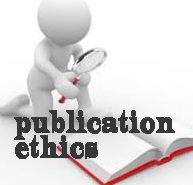POTENSI ANTIBAKTERI EKSTRAK n-HEXANA, ETIL ASETAT, ETANOL DAUN SARANG BANUA (Clerodendrum fragrans VENT WILLD) TERHADAP Salmonella enterica
Abstract
ABSTRAK
Eksplorasi antimikroba berbasis tanaman sangat diperlukan saat ini sebagai upaya pengembangan penyediaan bahan baku alternative obat infeksi bakteri alami. Penelitian ini bertujuan untuk mengetahui jenis ekstrak daun tumbuhan local sarang banua (Clerodendrum fragrans Vent Willd) yang berpotensi sebagai antibakteri terhadap Salmonella enterica. Sampel daun C. Fragrans diperoleh dari desa Raya Usang, Kecamatan Dolok Masagal, Kabupaten Simalungun, Sumatera Utara. Serbuk daun C. Fragrans dimaserasi dengan pelarut bertingkat kepolarannya sehingga diperoleh ekstrak etanol (polar), etil asetat (semi-polar) dan n-heksana (non-polar). Masing-masing jenis ekstrak diuji dengan variasi konsentrasi 10%, 5%, 2,5%, dan 1,25%. Kloramfenikol digunakan sebagai kontrol positif dan DMSO sebagai kontrol negative. Metode uji antibakteri dilakukan dengan metode difusi cakram. Hasil penelitian menunjukkan bahwa aktivitas antibakteri (diameter zona hambat) terbesar terhadap Salmonella enterica secara berurutan adalah ekstrak etanol 5% (polar) sebesar 14,0 mm, ekstrak n-heksan 10% (non-polar) sebesar 11,6 mm, dan ekstrak etilasetat 10% (semi-polar) sebesar 10,5 mm. Ekstrak etanol daun C. fragrans Vent Willd memiliki potensi antibakteri yang sangat baik terhadap Salmonella enterica. Hasil penelitian ini dapat digunakan sebagai bahan pertimbangan pemilihan jenis ekstrak pelarut dalam penyediaan daun C. fragrans sebagai bahan baku obat antibakteri alami.
Keywords
Full Text:
PDFReferences
Abakar, H., Bakhiet, S., and Abadi, R. (2017). Antimicrobial activity and minimum inhibitory concentration of Aloe vera sap and leaves using different extracts. Journal of Pharmacognosy and Phytochemistry, 6(3):298-303.
Ali, M.A., Lafta, A.H., and Jabar, S.K. (2014). Antibacterial activity of alkaloidal compound isolated from leaves of Catharanthus roseaus (L.) against multi-drug resistant strains. Research in Pharmaceutical Biotechnology. 5(2): 13-21.
Amin, L.Z. (2014). Pemilihan Antibiotik yang Rasional. Medicinus, 27(3): 40-45.
Arokiyaraj, S., Sripriya, N., Bhagya, R., Radhika, B., Prameela, L., and Udayaprakash, N.K. (2012). Phytochemical screening, antibacterial and free radical scavenging effects of Artemisia nilagirica, Mimosa pudica and Clerodendrum siphonanthus - An in-vitro study. Asian Pacific Journal of Tropical Biomedicine, S601-S604.
Bintang, M. (1993). Studi antimikroba dari Streptococcus lactis BCC2259. Disertasi. Institut Teknologi Bandung, Bandung.
Crump, J.A., Luby, S.P. and Mintz, E.D. (2004). The global burden of typhoid fever. Bull World Health Organ 5: 346-353.
Cushnie, T.P., & Lamb, A.J. (2005). Antimicrobial activity of flavonoids. International Journal of Antimicrobial Agents, 26: 343–356.
Darsana, I.G.O., Besung, I.N.K. and Hapsari, M. (2012). Potensi daun binahong (Anredera cordifolia (Tenore) steenis) dalam menghambat pertumbuhan bakteri Escherichia coli secara in vitro. Jurnal Indonesia Medicus Veterinus, 1:337-351.
Davis, W.W. and Stout, T.T. (1971). Disc Plate Method of Microbiological Antibiotic Assay. Microbiology, 22:659-665.
Effa, E.E., Lassi, Z.S., Critchley, J.A., Garner, P., Sinclair, D., Olliaro, P.L and Bhutta, Z.A. (2011). Fluoroquinolones for treating typhoid and paratyphoid fever (enteric fever). Cochrane Database Syst Rev 10: CD004530.
Febrina, L., Riris, I.D. dan Silaban, S. (2017). Uji aktivitas antibakteri terhadap Escherichia coli dan antioksidan dari ekstrak air tumbuhan binara (Artemisia vulgaris L.). Jurnal Pendidikan Kimia. 9(2):311-317.
Haraga, A, Ohlson, M.B. and Miller, S.I. (2008). Salmonellae interplay with host cells. Nat Rev Microbiol, 6(1):53-66.
Harborne, J.B. (1998). Phytochemical methods: a guide to modern techniques of plant analysis. 3rd edition. Chapman & Hall. London, UK, 302.
Martin, K.W. and Ernst, E. (2003). Herbal medicines for treatment of bacterial infections: a review of controlled clinical trials. J Antimicr Chemother, 51:241-246.
Misnadiarly dan Djajaningrat. (2014). Mikrobiologi
untuk Klinik dan Laboratorium. Jakarta: Rineka Cipta.
Moat, A.G., Foster, J.W. and Spector, M.P. (2002). Microbial Physiology Fourth Edition. New York: Wiley-Liss.
Monte, J., Abreu, A.C., Borges, A., Simoes, L.C. and Siomes, M. (2014). Antimicrobial Activity of Selected Phytochemicals against Escherichia coli and Staphylococcus aureus and Their Biofilms. Pathogens. 3: 473 – 498.
Nelwan, R.H. (2010). Pemakaian Antimikroba Secara Rasional Di Klinik. Jakarta : Interna Publishing. Cetakan kedua:2896-2900.
Qamar, F. N., Azmatullah, A., Kazi, A. M., Khan, E. and Zaidi, A. K. M. (2014). A three-year review of antimicrobial resistance of Salmonella enterica serovars Typhi and Paratyphi A in Pakistan. The Journal of Infection in Developing Countries, 8: 981-986.
Rosyidah, K., Nurmuhaimina., Komari. dan M.D. Astuti. (2010). Aktivitas Antibakteri Fraksi Saponin dari Kulit Batang Tumbuhan Kasturi. Mangifera casturi Bioscientiae, 7 (2): 25-31.
Simorangkir, M., Sitepu, M. dan Simanjuntak, P. (2013). Aktivitas Antibakteri Ekstrak Daun Sarang banua (Solanum Blumei Nees Ex Blume) Terhadap Salmonella typhimuriu. Prosiding SNYuBe, 382-389.
Simorangkir, M., Saragih, S.H., Nainggolan, B. and Silaban, S. (2018). Secondary Metabolites Phytochemical Analysis of n-Hexane, Ethyl Acetate And Ethanol Extracts of Sarang Banua (Clerodendrum Fragrans Vent Willd) Leaves. In Book of Program of The 2nd International Conference on Innovation in Education, Science and Culture (ICIESC), Medan City Indonesia, pp.6.
Smallwood, M. (1996). Handbook of Organic Solvent Properties, John Wiley & Sons Inc., New York, P.7, 65, 227.
Venkatanarasimman, B., Rajeswari, T. and Padmapriya, B. (2012). Antibacterial Potential of Crude Leaf Extract of Clerodendrum philippinum Schauer. International Journal of Pharmaceutical & Biological Archives, 3(2):307- 310
Wahyono, H. (2007). Peran Mikrobiologi Klinik Pada Penanganan Penyakit In- feksi. Makalah Pidato Pengukuhan Guru Besar Dalam Ilmu Mikrobiologi Fakultas Kedokteran Universitas Diponegoro.
Widyawati, P.S., Budianta, T.D.W., Kusuma, F.A. and Wijaya, E.L. (2014). Difference of solvent polarity to phytochemical content and antioxidant activity of Pluchea indicia Less leaves extracts. International Journal of Pharmacognosy and Phytochemical Research, 6 (4): 850-855.
Zang, Q.. (2015). Effects Of Extraction Solvents On Phytochemicals And Antioxidant Activities Of Walnut (Juglans Regia L.) Green Husk Extracts. European Journal of Food Science and Technology, 3 (5):15-21.
DOI: https://doi.org/10.24114/jbio.v5i2.13157
Article Metrics
Abstract view : 863 timesPDF - 5595 times
Refbacks
- There are currently no refbacks.

This work is licensed under a Creative Commons Attribution 4.0 International License.
INDEXING
JBIO : Jurnal Biosains (The Journal of Biosciences), Program Studi Biologi, Fakultas Matematika dan Ilmu Pengetahuan Alam, Universitas Negeri Medan. ISSN 2443-1230 (print) dan ISSN 2460-6804 (online)

Ciptaan disebarluaskan di bawah Lisensi Creative Commons Atribusi 4.0 Internasional.


.png)






